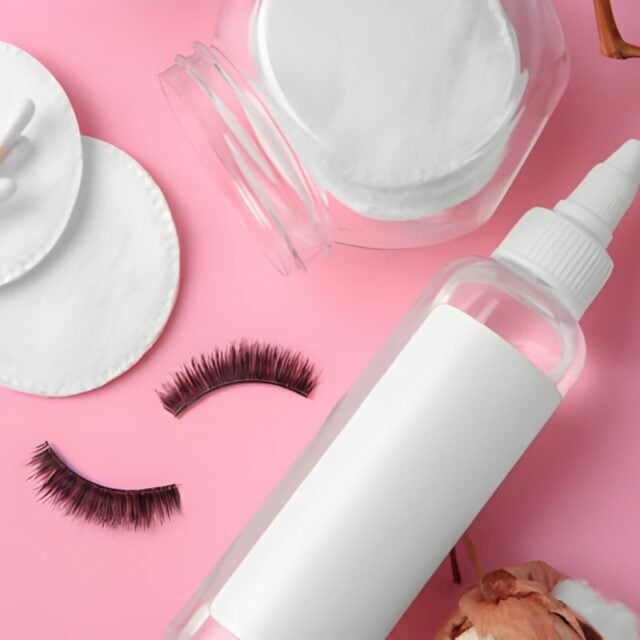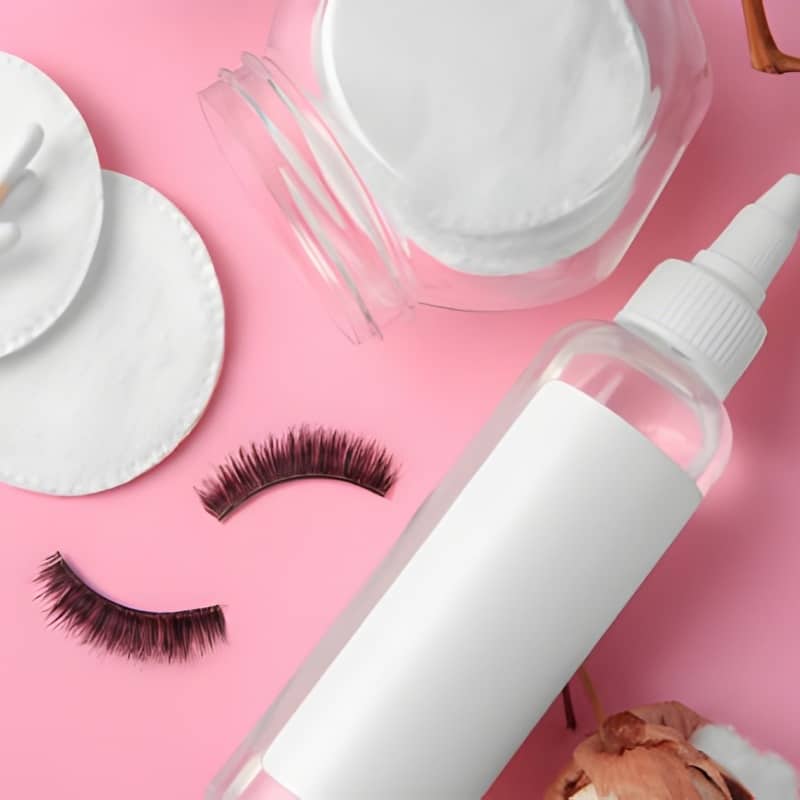
Everything that is sold in the beauty section might initially seem to be covered by the law governing cosmetics. Professionals and customers may become confused by the frequent display of nail glue, false eyelashes, lash adhesive, and removers together. Many people believe that a product must be a cosmetic if it is used in the beauty process. However, this presumption is not always accurate. Adhesive removers, whether marketed as an adhesive remover for fake nails or eyelash adhesive removers, perform a very different role than mascara, nail polish, or makeup removers.
Since these products don’t clean, perfume, protect, or beautify the human body, they aren’t considered cosmetics under EU regulations governing adhesive removers. Rather, they are classified as chemical products, and if their claims go beyond glue removal, they might even be covered by biocidal laws. This article explains why adhesive removers are not cosmetics, how they are classified under EU law, and what that means for brands and consumers.
What Is a Cosmetic According to EU Law?
Regulation (EC) No. 1223/2009 makes it clear what a cosmetic is. A cosmetic is any substance or mixture that is meant to be put on the outside of the body, mostly to clean, scent, change the way it looks, protect, or keep those parts in good shape. This definition sets limits: if the main purpose is not to improve appearance or keep things clean, but to do something else, like dissolve adhesives, the product is not covered by cosmetic law.
The European Commission’s Borderline Manual makes things clearer for hard cases. When used to attach fake nails or lashes for decorative purposes, adhesives can sometimes be thought of as cosmetics. But adhesive removers are very different. Their main job is to work on glue, not on the body. Because of this, EU law does not consider them cosmetics.
Adhesive Remover for Fake Nails
Strong cyanoacrylate glues hold fake nails in place, but they can be hard to get off. Fake nails have special products that are meant to break down the bonds that hold them together. Solvents like acetone or ethyl acetate are often used to make them because they can easily soften or dissolve glue. Some brands add oils or moisturizers to make the process less harsh on natural nails, but these additions are not the main focus.
The main goal is not to make things look better or take care of nails, but to get rid of them. That difference is very important. Even if a remover says it will be “gentle on natural nails,” EU law says it is based on what it does best. It is not a cosmetic because its main purpose is technical: to break an adhesive bond. It is instead subject to chemical regulation. Because of this, manufacturers must follow REACH and CLP rules, which include proper labeling and hazard classification. They must also provide Safety Data Sheets (SDS).
Eyelash Adhesive Remover
The glue that holds false eyelashes and extensions on is often stronger and lasts longer than nail glue. You need special solvents that are sold as eyelash adhesive removers to safely get rid of them. These products are usually gels or creams that lash technicians or people at home use to remove glue without hurting natural lashes.
Even though the packaging says these removers are “lash-friendly” or “nourishing,” their main job is still to get rid of glue. Removers are not cosmetics like mascaras or lash serums that make lashes look better or condition them. They are only for removing makeup. Because of this, EU regulators put them in the category of chemical products. If the remover also says it has antimicrobial or disinfecting properties, it may fall more under the Biocidal Products Regulation (EU) 528/2012.
Adhesive Remover Regulation EU
EU law gives a clear set of rules for figuring out where adhesive removers go. The Borderline Manual says that classification is based on how the item will be used, what it claims to do, and how it is presented. If a product is sold as an adhesive remover, it is not meant to clean or improve the body; it is meant to dissolve glue. This means it is not subject to cosmetic law.
But there can be cases that are on the edge. If a nail remover is marketed mainly as a nail care product that “restores shine” and only secondarily as a glue remover, regulators may look at the cosmetic parts. Still, the main purpose is always the most important thing. In most cases, glue removal is the most important thing, so chemical classification is the best way to go.
When a remover says it can kill germs, things get even clearer: the product becomes a biocide, which has much stricter rules for approval and labeling. This shows how important it is to choose the right words for labels, websites, and ads.
Why Adhesive Removers Are Not Cosmetics
There are several reasons why EU regulators consistently exclude adhesive removers from cosmetics law. The most important thing is function. Cosmetics must beautify, cleanse, or protect; adhesive removers do none of these. Their purpose is to break adhesive bonds, a technical and chemical process unrelated to appearance.
Another reason lies in regulatory requirements. Cosmetics require a Cosmetic Product Safety Report (CPSR), a responsible person designation, and notification in the CPNP. Adhesive removers require chemical safety measures instead: hazard classification, warning symbols, and compliance with REACH and CLP. A misclassified product could lead to recalls, penalties, or market withdrawal. Finally, regulators do not consider shop placement or consumer assumptions. Even if a remover is sold next to nail polish and mascara, its classification depends on its purpose. For this reason, adhesive remover for fake nails and eyelash adhesive removers remain outside the cosmetic category.
Possible Grey Areas
There are some grey areas, even though the rules are clear. Authorities may pay more attention to a remover if it is heavily marketed for its cosmetic benefits, such as “conditioning eyelashes” or “nourishing natural nails.” But even then, the classification will still be chemical if the main goal is to get rid of glue.
If the product says it can disinfect or sterilize, the exception is clearer. In that case, it stops being a cosmetic and a general chemical law and becomes a biocide. The Biocidal Products Regulation says that this must be approved, which means that active substances must be carefully tested.
Practical Guidance for Brands
The regulatory ramifications are substantial for businesses that manufacture or market adhesive removers. First, marketing claims need to be written with care. It is risky to market a remover as a cosmetic since regulators might contest the classification. It is safer to refer to the product as a glue remover or dissolver rather than a lash or nail care product.
Second, safety records are essential. Companies are required to create Safety Data Sheets and adhere to hazard labeling regulations in place of cosmetic safety reports. Consumers must be informed about solvent risks, safe use, and storage by packaging. Fines or enforcement action may follow noncompliance.
Third, businesses ought to inform customers. Many people mistakenly believe that adhesive removers are cosmetics, which can result in misuse. Accidents can be avoided with clear instructions and warnings, particularly when using products close to the eyes.
Frequently Asked Questions
Q1. Is fake nail glue remover considered a cosmetic?
No, because its primary purpose is to dissolve glue, which is not what EU law defines as cosmetic.
Q2. How is the EU regulating eyelash adhesive remover?
According to REACH and CLP, it is typically categorized as a chemical product. It may be regulated as a biocide if it makes antimicrobial claims.
Q3. What is the significance of the Borderline Manual?
It clarifies that adhesive removers are not cosmetics and offers advice on challenging classifications.
Q4. Are adhesive removers ever going to be considered cosmetics?
Though this is rare, it only occurs in situations where the primary claim is cosmetic care.
Q5. What paperwork is needed for adhesive removers?
Adhesive removers require chemical safety documentation, such as Safety Data Sheets and appropriate hazard labeling, in place of CPSR.
Conclusion
Adhesive removers are often sold with makeup, but they are not the same thing. The purpose of both eyelash adhesive remover and fake nail adhesive remover is to break down glue, not to make the body look better. According to EU rules, adhesive removers are not cosmetics but rather chemical products, and sometimes biocides. This means that brands need to make sure they are correctly classifying, documenting, and labeling their products. For consumers, it means knowing that these items are not cosmetics but rather technical solutions that need to be handled safely.
Our experts at Certified Cosmetics can help you figure out how to classify your product if you’re not sure if your adhesive remover is a cosmetic, a chemical, or even a biocide. We help you make sure your products meet EU standards by giving you regulatory advice, help with product classification, and compliance paperwork.
Check out Certified Cosmetics services today to get personalized advice on how to make sure your cosmetics are safe and follow the rules.

